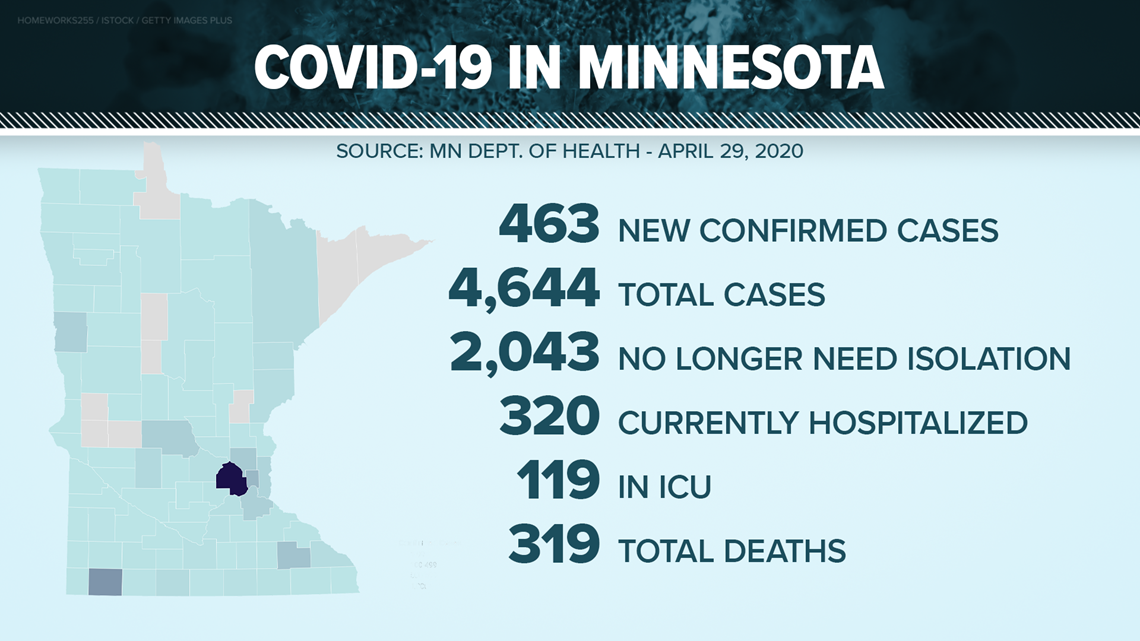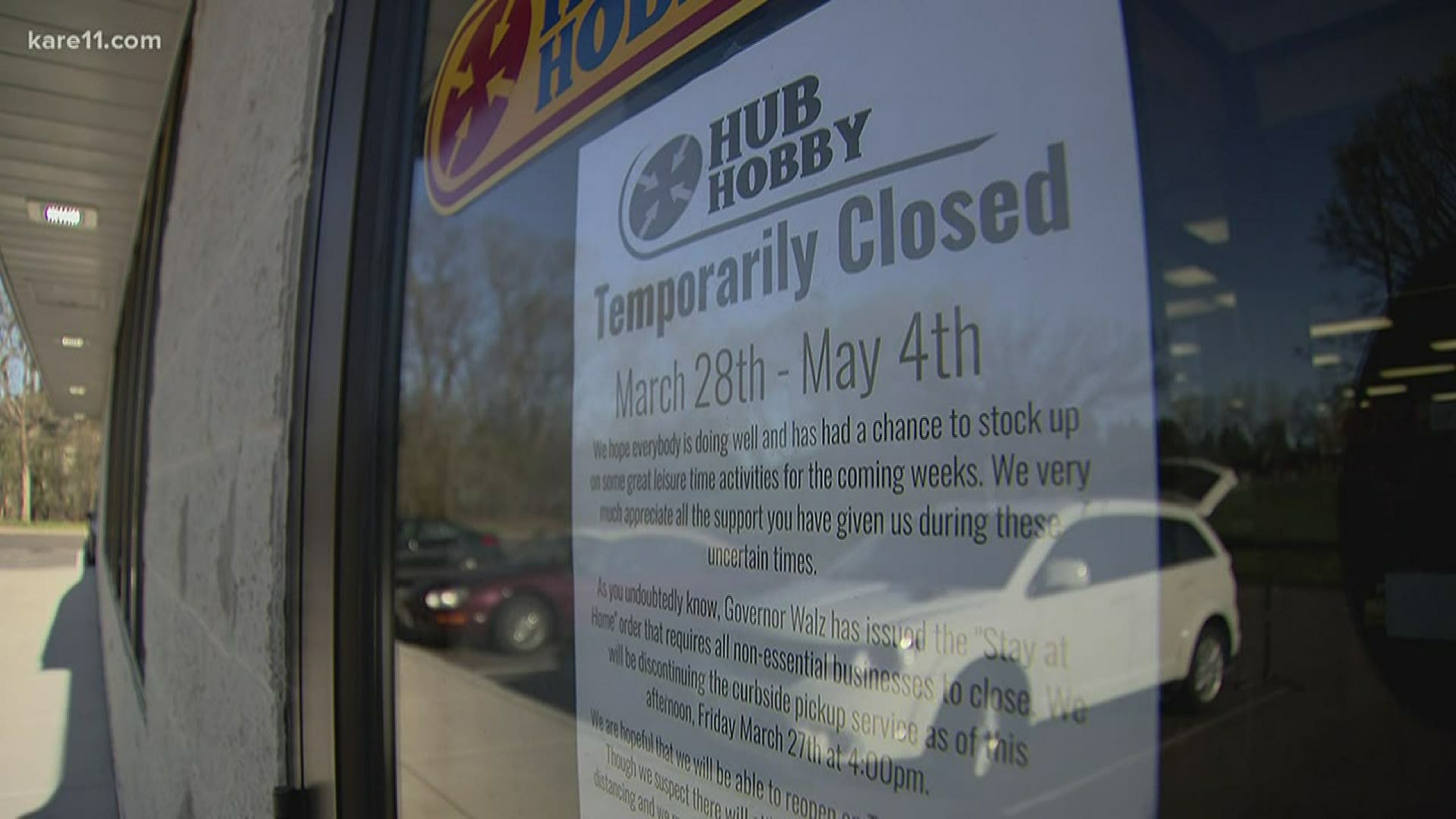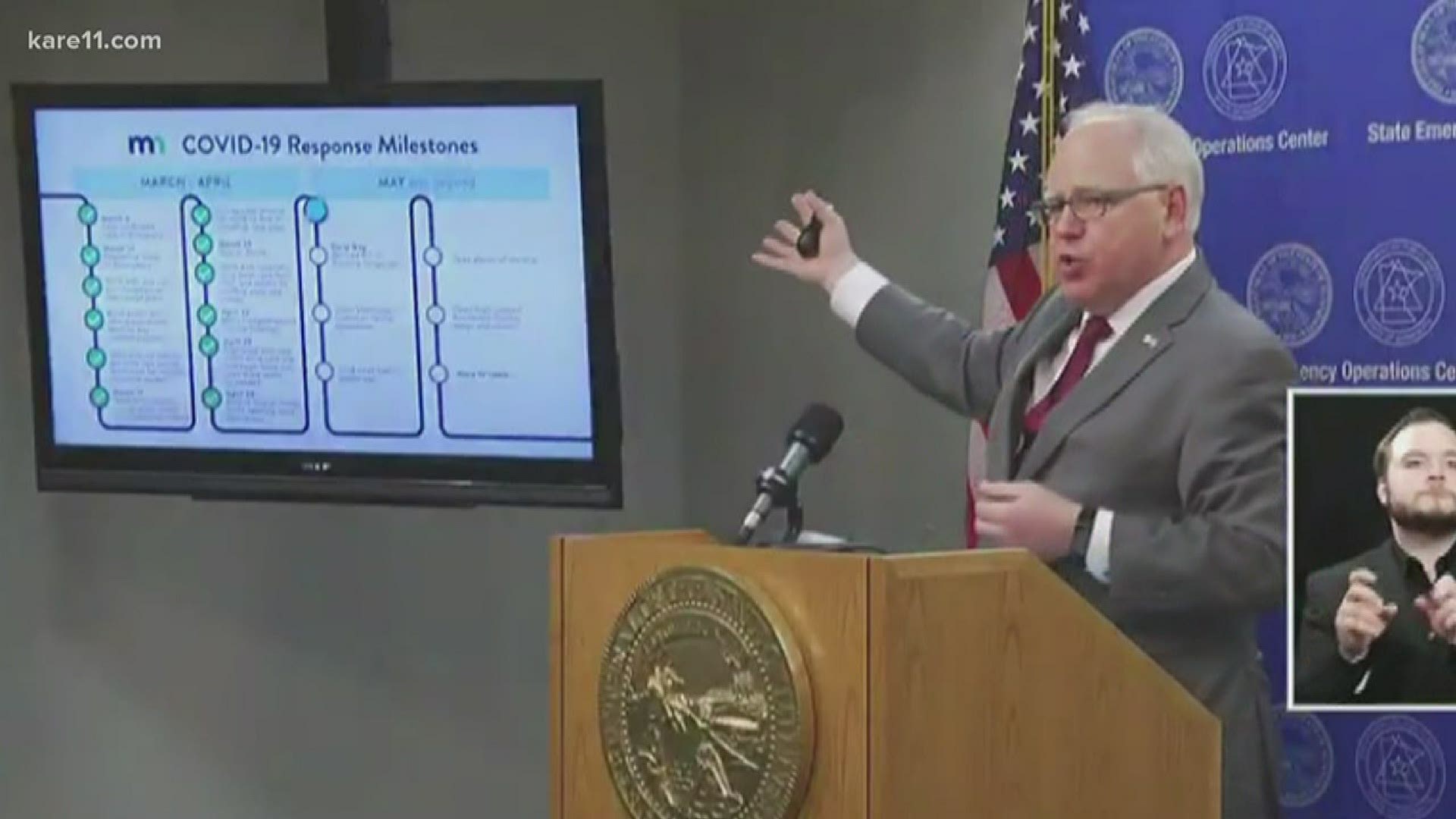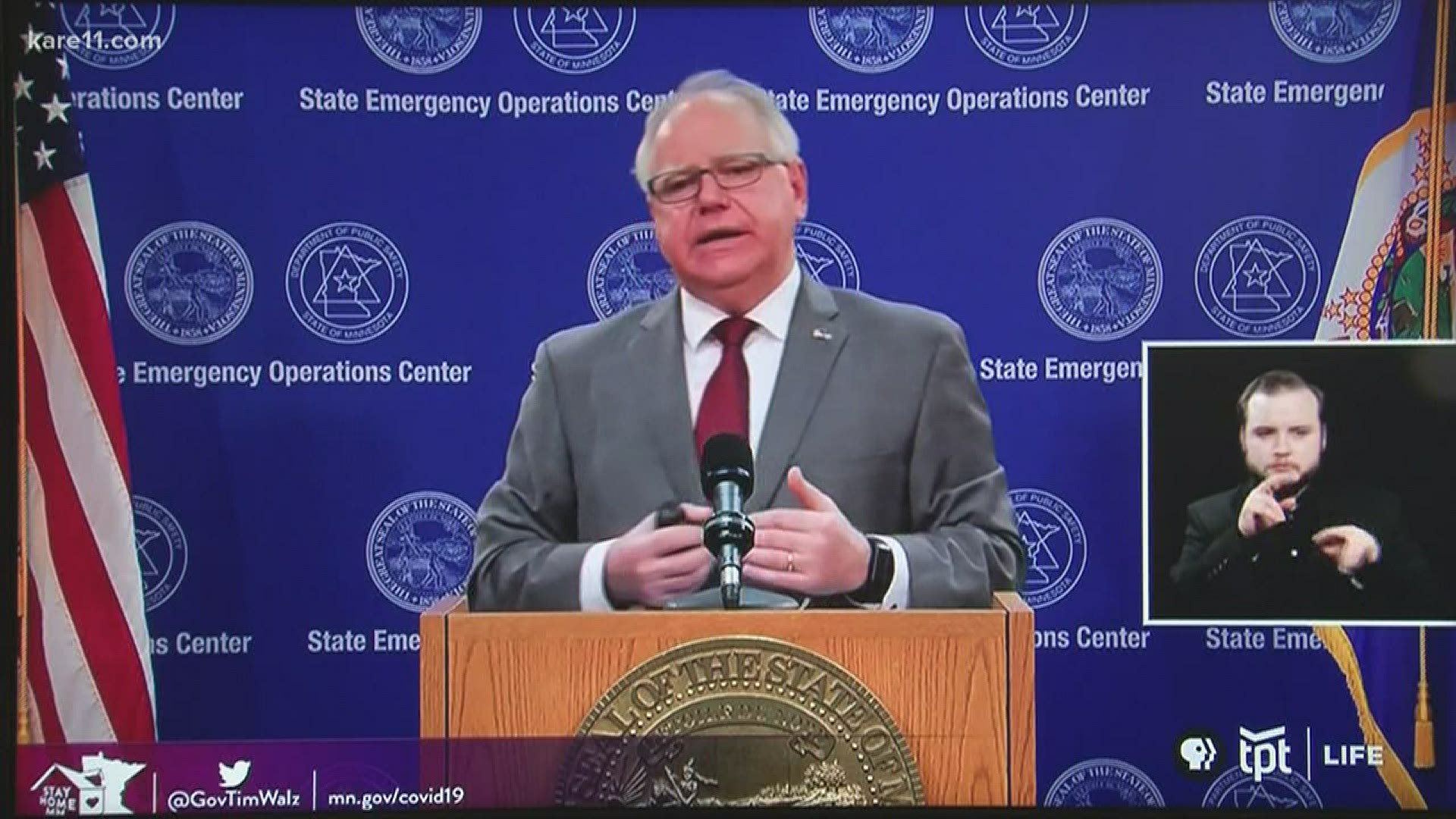ST PAUL, Minn. — Thursday, April 30
2 p.m.
Minnesota Gov. Tim Walz has extended the state's Stay at Home order until May 18, with some loosened restrictions on retail.
The order was previously set to expire May 4. Walz held a news conference Thursday afternoon, beginning by saying, "I think it's time to assess where we’re at."
Retailers are being asked to make a plan outlining how they will reopen while following public health guidelines. They will be allowed to sell their inventory using curbside pickup and delivery beginning on Monday, May 4. The state is recommending that everyone wears masks, including employees and customers.
Bars and restaurants will remain closed for dine-in service until at least May 18.
Department of Employment and Economic Development (DEED) Commissioner Steve Grove said they expect this update to allow 30,000 people to go back to work, or approximately 10,000 businesses.
It includes any customer-facing retail establishment in Minnesota that sells, rents, maintains or repairs goods and can reasonably implement social distancing and pickup or delivery. In addition to traditional retail, it includes household goods rentals, maintenance services, repair services and pet grooming. It allows salons and barbershops to open up the retail portions of their businesses.
The state will not be asking businesses to submit their plans for review, but they reserve the right to ask for them. Businesses are asked to do health screenings for employees. Customers are not to be allowed inside the stores. Grove said they "strongly suggest" contactless payment, as well.
More details are available for businesses on the DEED website.
Walz said that there will be no changes at this time for campgrounds or other outdoor facilities that have been closed.
The governor said Thursday that the state has moved to opening about 82% of businesses in some capacity, but said "that is little comfort to the 18% that aren't."
The Stay at Home order was originally put in place on March 27, to slow the spread of COVID-19 and give the state time to ramp up their hospital capacity. On April 8, Walz extended the order until May 4.
At that time, he built in a “mechanism” that allowed businesses to be gradually allowed back to work as they submit plans to show that they can implement public health recommendations like proper hygiene and social distancing. This past Monday, the state estimated 100,000 people went back to work in nonessential manufacturing, industrial and office jobs.
Minnesota Department of Health Commissioner Jan Malcolm has said that whatever happens with the Stay at Home order, Minnesotans can expect measures like social distancing and wearing masks in public to stay in place.
Wearing masks and not congregating together “will probably continue for some time,” Walz said. He acknowledged Thursday that while the "dial" turns up slowly to allow businesses to get back to work, people will still be asked to social distance and stay home, and distance learning will continue for students. People will be asked to telework if possible "for some time."
Walz said he hopes to revise the ban on elective surgeries in the coming days, and that his office is looking for public input. "The hospitals will be the ones that sign off on this," he said.
Beyond that, the next steps would be opening more customer-facing businesses, and then allowing small family gatherings, Walz said. After that, opening places of worship. Opening high-contact businesses like barber shops and salons would come after that.
“Continue what you’re doing in the social distancing,” Walz urged his audience. “Even if there were not a Stay at Home order … that is the surest way to get beyond this and get things back to the way we want them to be.”
RELATED: Health Commissioner speaks candidly on testing, the Stay at Home order and fate of State Fair
Walz said that the data shows Minnesotans have saved lives and bought critical time by staying home. He said he believes that the COVID-19 peak has been pushed out to the end of May or beginning of June.
"I think today there’s a lot of positives to talk about in Minnesota,” he said, while acknowledging that it is against the backdrop of the highest one-day death toll yet.
The state has built up hospital capacity and finalized a lease on an alternate care site to make sure everyone who needs care can receive it. There are other potential sites identified, as well.
“Should a surge come and the capacity be needed to overflow, we could stand those up in 72 hours," he said. "We proved we could do it, it’s there, and that just adds to our capacity.”
The state is still working to acquire more personal protective equipment (PPE) for health care workers.
Walz also pointed out the testing strategy his office is working on with the Minnesota Department of Health, Mayo Clinic and the University of Minnesota. The goal is to get to 20,000 diagnostic tests per day and 15,000 antibody tests per day in the coming weeks.
Walz said the state’s objectives moving forward include:
- Minnesotans living healthy, safe and happy lives
- Slow spread and slowly build immunity, realizing elimination is impossible
- Strategically get more Minnesotans back to work
- Safely and slowly resume in-person contact and other activities
The governor said he's not saying that we'll be "out of it" by May 18. He emphasized that the virus is dictating when restrictions end or loosen.
"We have set parameters, we have set goals, we have turned the dial," he said. "You crank that dial wrong, and it is catastrophic what it can do."
Walz implored Minnesotans Thursday to not just focus on the extended date of May 18.
"Things have changed here, and they've changed for the positive," he said. "Let's grind it out the last few miles of this marathon and get to the other side."
11 a.m.
State health officials are backing up their commitment to ramp up COVID-19 testing across Minnesota with new numbers that reflect significant increases in both tests and cases.
The Minnesota Department of Health reports 3,532 tests performed and 492 new cases in the last day, the highest number of both since the pandemic began. The state now totals 5,136 people who have tested positive, and 70,276 tests performed in state and private labs.
Men now account for half of the state's coronavirus cases.
MDH also confirms 24 additional deaths across Minnesota in the last day, bringing the total to 343 since the department began compiling statistics in late January. People who were 70 or older make up 83% of those fatalities, most of them in long term or congregate living situations. Those between ages 60 and 69 make up 12% of COVID-19 deaths.
As of Thursday 365 coronavirus patients are being cared for in Minnesota hospitals, with 130 of them in ICU. The total number of people who have required hospitalization for the virus now stands at 1,044.
Health officials say 2,172 people who at one time tested positive for COVID-19 have now recovered sufficiently to no longer require isolation.
Hennepin County reports the most cases of the coronavirus by far, with 1,738 and 225 deaths. Nobles County, a hot spot linked to the now-closed JBS pork processing plant, reports 742 cases with one death. Ramsey County has 374 cases and 26 deaths, Stearns County reports 267 cases, while Olmsted County confirms 265 cases and six fatalities.
Wednesday, April 29
2 p.m.
State health and emergency officials held their daily update call on the status of the COVID-19 pandemic in Minnesota on Wednesday afternoon.
Minnesota Department of Health Commissioner Jan Malcolm said the increase of 463 cases reported Wednesday represents the focus on increased testing, both specifically in the southwest part of the state and more broadly.
The majority of the 18 additional deaths reported Wednesday were in long-term care, Malcolm said.
"We are doing more testing and we are seeing more cases," said MDH Infectious Disease Director Kris Ehresmann. "We are going to continue to see more cases as we continue to do more testing, and that is not necessarily a bad thing."
Ehresmann said that the increase in identified cases means that they can track others who have been in contact with those people and keep them isolated, limiting the spread.
The rate of fatalities is also dropping, Ehresmann said, as they begin to widen the range of testing.
Minnesota's Director of Homeland Security and Emergency Management Joe Kelly said the state has come to an agreement to use a Presbyterian Homes facility in Roseville as an alternate care site.
His department has been working to identify alternate care sites across the state. They have 1,800 additional hospital beds at the ready, should they be needed for overflow care when COVID-19 cases spike. These non-hospital sites could be used for less serious medical needs like recovery from surgeries, while hospital beds are used for intensive care.
Kelly said he hopes these sites will not be needed, but "hope is not a plan."
"Things are looking really good," said MDH Assistant Commissioner Marie Dotseth regarding Minnesota's readiness for the COVID-19 peak.
"We're monitoring bed capacity daily, we're monitoring what's going on in different cities," she said. "Every day that goes by we learn a little bit more and we're feeling confident that we will see a surge but we are well prepared capacity-wise with what we've planned so far."
For Minnesotans who have applied for unemployment insurance, DEED Commissioner Steve Grove has a message: "Don't worry, it's coming."
"You don't have to call in and follow up," he said. "We are tracking every single application."
He also offered a reminder that independent contractors and self-employed workers will receive the extra $600 payment they're eligible for under the federal CARES Act.
"We are working hard on this, we are back-dating every single payment from the moment you are eligible," Grove said.
Grove announced a new tool for businesses in Minnesota, MN Symptom Screener, to help them navigate health screenings for employees.
Additionally, Grove said Target is making a supply of no-touch infrared forehead thermometers available to Minnesota businesses at cost. More information is available on the DEED website.
While Gov. Tim Walz has not announced whether he will extend the state's Stay at Home order set to expire Monday, Malcolm said the guidance to social distance and wear cloth masks in public is not going anywhere.
"The guidance to stay close to home, to restrict large gatherings, to restrict close contact with anyone outside of your household, those things are going to stay in place," Malcolm said.
She said the conversations about reopening the economy are interdisciplinary and involve multiple departments.
"He's perfectly mindful of the fact that we're in a growth phase of the pandemic and we're gonna see more cases, and unfortunately we're gonna see more deaths," Malcolm said.
Malcolm said she "can't stress enough" how important it is for the community to continue to work together to reduce the spread, even as the state begins to reopen more businesses.
Of Wednesday's 18 deaths, 16 of them were in long-term care facilities. Around 99% of people who have died from coronavirus in Minnesota had underlying health conditions.
The number of cases is not always a function of whether a long term care facility is following guidelines or not, Malcolm said citing the worldwide shortage of PPE as an example.
11 a.m.
Numbers released Wednesday by the Minnesota Department of Health (MDH) reflect the push to ramp up testing across Minnesota, with the largest single-day increase in both cases and tests since the start of the COVID-19 pandemic.
MDH says 2,915 people were tested for the coronavirus in the past day, bringing the total of tests administered in state and private labs to 66,744. In the last day 463 people tested positive for the virus, bringing the total of Minnesota cases since late January to 4,644.


Sadly, an additional 18 people have died, bringing fatalities in the state to 319. State health officials say 83% of those who have died from complications of COVID-19 were age 70 or above, with 13 percent between the ages of 60 and 69.
Of those testing positive, 320 are currently being treated in hospitals, with 119 of those experiencing symptoms serious enough to be cared for in the ICU. Since the pandemic started, 950 Minnesotans have required hospitalization.
MDH says 2,043 people who contracted the coronavirus have recovered enough to no longer require isolation.
KARE 11’s coverage of the coronavirus is rooted in Facts, not Fear. Visit kare11.com/coronavirus for comprehensive coverage, find out what you need to know about the Midwest specifically, learn more about the symptoms, and see what companies in Minnesota are hiring. Have a question? Text it to us at 763-797-7215. And get the latest coronavirus updates sent right to your inbox every morning. Subscribe to the KARE 11 Sunrise newsletter here. Help local families in need: www.kare11.com/give11.
The state of Minnesota has set up a hotline for general questions about coronavirus at 651-201-3920 or 1-800-657-3903, available 7 a.m. to 7 p.m.



